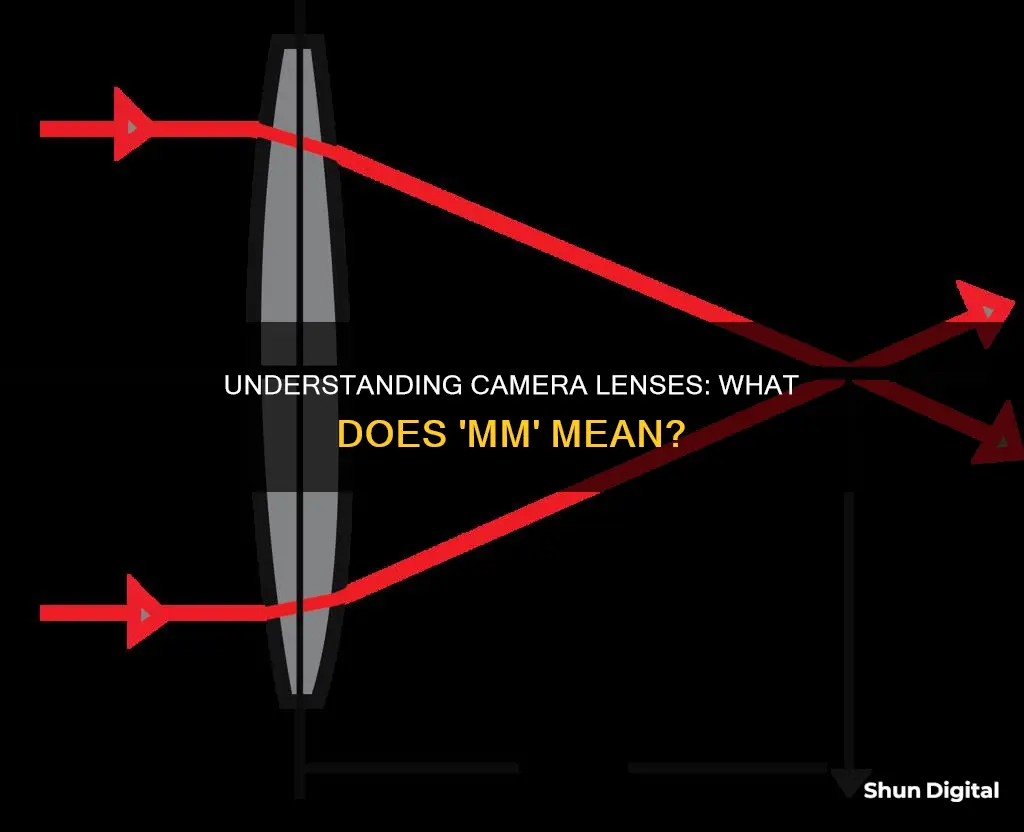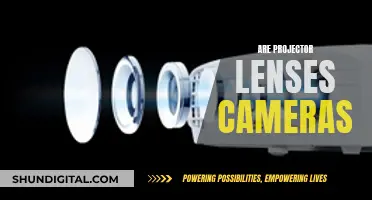
The 'mm' on a digital camera lens stands for millimetres and is used to measure the focal length of the lens. The focal length is the distance from the centre of the lens to the image focal point (or image sensor surface). A lens with a short focal length is a wide-angle lens, and one with a long focal length is a telephoto lens. The lower the number in mm, the wider the pictures, and the bigger the number, the more zoomed in the picture is.
| Characteristics | Values |
|---|---|
| What does mm stand for? | Millimetres |
| What does it refer to? | Focal length, diameter of the lens, aperture (the size of the opening), and other properties such as filter size |
| What does it tell us about a lens? | How much of a scene you can see when looking through it |
| What is the focal length? | The distance from the centre of the lens to the image focal point (image sensor surface) |
| What is the impact of the focal length on the image? | The lower the focal length, the more you will see in your image (wider view). The higher the focal length, the less you will see in your image (more zoomed in). |
What You'll Learn

Focal length
The 'mm' on a camera lens stands for millimetres and is a measurement of the focal length of the lens. The focal length is the distance from the optical centre of the lens to the camera's sensor when focused on infinity.
Lenses with shorter focal lengths (less than 50mm) are known as wide-angle lenses. They have a wider field of view and are often used for landscape photography. Lenses with longer focal lengths (more than 50mm) are known as telephoto lenses. They have a narrower field of view and are useful for portraits or sports photography where you want to isolate the subject from the background.
The focal length of a lens is also affected by the size of the camera's image sensor. For example, a 50mm lens on a camera with a smaller image sensor will behave more like a telephoto lens because the smaller sensor crops the image and makes the field of view narrower.
Why Are Camera Lenses So Affordable?
You may want to see also

Field of view
The field of view (FOV) is the maximum area of a scene that a camera lens can capture in a single shot. It is influenced by the focal length of the lens and the size of the camera's image sensor. The FOV is usually expressed in angular or size terms, with the former indicating the full angle in degrees and the latter denoting the length in millimetres or meters.
The focal length of a lens is the distance between the lens and the camera's sensor when focused on infinity. It is measured in millimetres (mm) and determines how much of a scene the camera will be able to capture. A lower focal length (smaller number) will give you a wider field of view, while a higher focal length (larger number) will result in a more zoomed-in image. For example, a 17mm lens will provide a very wide field of view, while a 200mm lens will be highly zoomed in, capturing only a small part of the scene.
The size of the camera's image sensor also affects the field of view. A larger sensor will provide a wider field of view if the lens focal length remains fixed. On the other hand, a camera with a smaller image sensor, such as an APS-C or micro 4/3 sensor, will have a narrower field of view as the smaller sensor crops the image.
The field of view can be measured in degrees, with the angular field of view (AFOV) being the angle between any light captured horizontally and any light captured at the edge. Optical tests are commonly used to determine the FOV, particularly for UV, visible, and infrared cameras. These tests involve focusing light from a black body (an object that absorbs all light) onto a test target at the focal place, creating a virtual image at an infinitely far distance.
Selling Camera Gear: Strategies for Moving Inventory
You may want to see also

Zoom
The benefit of a zoom lens is its versatility. They are ideal when photographing a variety of subjects, such as landscapes and portraits, and you only want to use one lens. Using a zoom lens also reduces the number of times you need to change the lens, saving time and limiting the possibility of dust entering the camera's mirror box or sensor.
Long-range zoom lenses can fit a very wide array of focal lengths into a single lens, such as 18-200mm, while short-range zoom lenses usually offer a focal range of 50mm or less. The zoom ability does increase the risk of getting distortions or aberrations in your image, but you can lower the chance of this happening by choosing a high-quality lens and taking time to study photography methods.
When choosing a zoom lens, it is important to consider the focal length range you require for your specific needs. For example, a 100-400mm lens would have a zoom factor of 4x, while an 18-72mm lens would also have a zoom factor of 4x, despite having a smaller maximum focal length.
It is also worth noting that the sensor size of your camera can affect the zoom level of a lens. For example, on a camera with a smaller image sensor (such as an APS-C sensor), a 50mm lens would behave more like a telephoto lens, as the smaller sensor crops the image and makes the field of view narrower.
The Creative Power of Normal and Wide Angle Lenses
You may want to see also

Diameter
The diameter of a camera lens is the measurement of the front part of the lens, which is crucial in taking a good picture. The diameter is measured in millimetres, from one side of the front of the lens to the other. The bigger the lens diameter, the more light it lets in, which can be used to produce higher picture resolution and image brightness.
The diameter of a lens is different from its focal length and aperture. The focal length is the distance between the optical centre of the lens and the camera's sensor when focused on infinity, and the aperture is the size of the opening that lets in light. The lens diameter is often marked on the lens using the symbol "ø" followed by a number, for example, ø52 for a 52mm diameter. Common DSLR lens diameters include 52mm, 58mm, 72mm, and 77mm.
When buying filters, lens caps, or hoods for your camera, it is important to know the diameter of your lens. While not all lenses have the same diameter, knowing the diameter of your lens will ensure that you purchase the correct size of accessories.
The Myth of Circular Camera Lenses: Fact or Fiction?
You may want to see also

Aperture
The aperture mechanism in the lens is formed of a series of opaque "blades" called a diaphragm. When the blades are open, more light will enter the camera, and when they are closed, less light will enter. This is similar to the human eye, where the iris expands or shrinks to control the size of the pupil.
The aperture is measured using "f-stops" or "f-numbers", which refer to the ratio of the lens's focal length to the effective aperture diameter. The lower the f-number, the wider the aperture, and the more light that will enter the camera. For example, f/1.4 is a wider aperture than f/22.
Camera Lenses: Weatherproof or Not?
You may want to see also
Frequently asked questions
MM stands for millimetres, which is the standard unit of measurement for the focal length of a lens.
The focal length of a lens is the measurement in millimetres of the distance from the optical centre of the lens to the camera's sensor when focused on infinity.
The focal length of a lens determines the angle of view and how much of the scene your camera will be able to capture. The lower the focal length (smaller number), the more you will see in your image (wider view). The higher the focal length (larger number), the less you will see in your image (more zoomed in).







